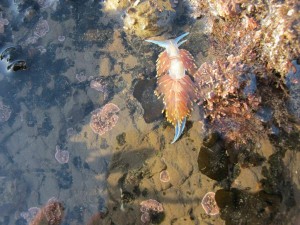Authors: Gaby and Jane
You are cruising along Sir Francis Drake Boulevard in a jam-packed suburban, each kid wrapped in infinite layers (of sweaters, hats, gloves, booties, and many many puffy jackets), snacking on homemade brownies, and bellowing the lyrics to one of the many archaic playlists found on old scratched-up CDs. Time flies as the car swerves around corner after corner, speeding through densely wooded forests, dry grasslands, quaint towns, and mountainous landscapes. And then just like that, you’ve arrived!
The second you crack open the car door, a revitalizing gust of salt water air fills your lungs. Soon you’re racing down a rocky path towards the beautiful landscape of Duxbury, seeing wayward waves breaking in the distance and a jumble of glistening tide-pools and rock formations sprawled out in front of you. As you come closer and closer you realize that the reef is carpeted in a thick layer of diverse algae and other types of marine life. By balancing your knees on a squishy cushion and gazing into the little world set out in front of you, you begin to discover all of the infinitesimal critters concealed under the outermost layers of the reef. Lifting the algae away reveals individually patterned limpets glued to bare rock, or a tribe of tightly packed turban snails huddling in a crevice. Vibrant giant green anemones and whimsical water creatures like the Hermisseda sea slug dance through your vision as you explore tide pool after tide pool.
After some time collecting valuable data by counting the critters and algae, the sun begins to melt into the sea and disappear behind walls of rolling peaks. Even as darkness surrounds you, the vibrant colors and senses of the day remain seared in your brain. Taking in one last gulp of the wild sea air, you turn your back on the sea and step back into reality.
Sustainable Seas, a community service club at the Branson School, monitors the rocky intertidal ecosystem at Duxbury Reef in Bolinas. We visit every couple months in order to find, identify, and count organisms living on the reef. In addition to the hustle and bustle of traveling to our monitoring site and scrambling over the rocks of intertidal ecosystem, we organize a routine pattern for counting critters. We search in between the layers of seaweeds to find turban snails, whelks, and the like. This data is then used to track the abundance of each species seasonally and over time. We are able to look back and analyze the trends and patterns of our data.
Consequently, Sustainable Seas contributes to the scientific knowledge of the rocky intertidal ecosystem at Duxbury Reef in Bolinas. We hope to see increasingly healthy numbers of critters as we continue to monitor. At the end of the day, we are windblown and shivering but know that we have contributed to the well-being of our local rocky intertidal ecosystem, making the packed-Suburban trips and scratched-up CDs worthwhile.


































